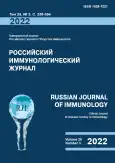Effect of graphene oxide nanoparticles on viability of BAP3 hybridoma cells
- Authors: Lazarev S.S.1,2, Bochkova M.S.1,2, Timganova V.P.2, Rayev M.B.1,2
-
Affiliations:
- Institute of Ecology and Genetics of Microorganisms, Ural Branch of the Russian Academy of Sciences, Branch of Perm Federal Research Center
- Perm State University
- Issue: Vol 25, No 3 (2022)
- Pages: 245-250
- Section: SHORT COMMUNICATIONS
- URL: https://journals.rcsi.science/1028-7221/article/view/120183
- DOI: https://doi.org/10.46235/1028-7221-1148-EOG
- ID: 120183
Cite item
Full Text
Abstract
Graphene oxide (GO) is a promising material, which is likely to find applications in the fields of medicine and biotechnology. However, the current knowledge of its influence on human organism is limited. Even less information is available on the effects of GO on the cell lines widely used in biotechnology. The aim of this work is to describe the interaction between GO nanoparticles and BAP3 hybridoma cells which produce anti-human-PSG1 IgG, in vitro. We studied the effect of GO nanoparticles on cell viability and the intensity of internalization (adhesion) of nanoparticles by the cells. We used GO nanoparticles of different size, with surface being functionalized by linear or branched PEG (GO-PEG). The PEG coating level was 20% (by mass). The following nanoparticle concentrations were used: 5 μg/mL and 25 μg/mL. The BAP3 cells were cultured in a 48-well cell culture plates in serum-free DCCM-1 media in the presence of GO nanoparticles. The cells were cultured for 24 hours at 37 °С and 5% СО2. Cell viability was assessed by a flow cytometer utilizing Zombie Aqua (ZA) staining. Internalization (adhesion) of nanoparticles was monitored using a flow cytometer by GO fluorescense in the samples (λex = 488 nm). Moreover, interactions between hybridoma cells and GO nanoparticles were visualized by EVOS M5000 visualization system, which included an inverted fluorescent microscope.
We demonstrated that GO nanoparticles possess a cytotoxic effect when applied at high concentration (25 μg/mL). The highest cytotoxic effect is caused by GO nanoparticles coated with linear PEG. The degree of nanoparticle internalization (adhesion) was shown to be significantly lower when the particles were present at lower (5 μg/mL) concentration. Internalization (adhesion) of nanoparticles of smaller size was more abundant. Furthermore, these nanoparticles were shown to have a stronger cytotoxic effect compared to larger particles. In general, cytotoxicity of GO nanoparticles decreases with increasing size, which is especially evident if the fact that the mean effective diameter of the nanoparticles coated with branched PEG is considered larger than their linear PEG-coated counterparts. The data obtained allow us to draw a correlation between the cytotoxic effect of GO nanoparticles and the level of their internalization (adhesion) by the cells. In general, this work concerns some novel aspects of interaction between GO nanoparticles and hybridoma cells.
Full Text
##article.viewOnOriginalSite##About the authors
S. S. Lazarev
Institute of Ecology and Genetics of Microorganisms, Ural Branch of the Russian Academy of Sciences, Branch of Perm Federal Research Center; Perm State University
Author for correspondence.
Email: lasest@vk.com
Engineer, Laboratory of Ecological Immunology; Bachelor, Department of Microbiology and Immunology
Russian Federation, Perm; PermM. S. Bochkova
Institute of Ecology and Genetics of Microorganisms, Ural Branch of the Russian Academy of Sciences, Branch of Perm Federal Research Center; Perm State University
Email: lasest@vk.com
PhD (Biology), Research Associate, Laboratory of Ecological Immunology; Senior Lecturer, Department of Microbiology and Immunology
Russian Federation, Perm; PermV. P. Timganova
Perm State University
Email: lasest@vk.com
PhD (Biology), Research Associate, Laboratory of Ecological Immunology
Russian Federation, PermM. B. Rayev
Institute of Ecology and Genetics of Microorganisms, Ural Branch of the Russian Academy of Sciences, Branch of Perm Federal Research Center; Perm State University
Email: lasest@vk.com
PhD, MD (Biology), Leading Research Associate, Laboratory of Ecological Immunology; Professor, Department of Microbiology and Immunology
Russian Federation, Perm; PermReferences
- Behzadi S., Serpooshan V., Tao W., Hamaly M.A., Alkawareek M.Y., Dreaden E.C., Brown D., Alkilany A.M., Farokhzad O.C., Mahmoudi M. Cellular uptake of nanoparticles: journey inside the cell. Chem. Soc. Rev., 2017, Vol. 46, no. 14, pp. 4218-4244.
- de Melo-Diogo D., Lima-Sousa R., Alves C.G., Costa E.C., Louro R.O., Correia I.J. Functionalization of graphene family nanomaterials for application in cancer therapy. Colloids Surf. B Biointerfaces, 2018, Vol. 171, pp. 260-275.
- Khramtsov P., Bochkova M., Timganova V., Nechaev A., Uzhviyuk S., Shardina K., Maslennikova I., Rayev M., Zamorina S. Interaction of graphene oxide modified with linear and branched PEG with monocytes isolated from human blood. Nanomaterials, 2022, Vol. 12, no. 1, 126. doi: 10.3390/nano12010126.
- Mitra S., Tomar P.C. Hybridoma technology; advancements, clinical significance, and future aspects. J. Genet. Eng. Biotechnol., 2021, Vol. 19, no. 1, 159. doi: 10.1186%2Fs43141-021-00264-6.
- Shareena T.P.D., McShan D., Dasmahapatra A.K., Tchounwou P.B. A review on graphene-based nanomaterials in biomedical applications and risks in environment and health. Nanomicro Lett., 2018, Vol. 10, no. 3, 53. doi: 10.1007/s40820-018-0206-4.
- Singh D.P., Herrera C.E., Singh B., Singh S., Singh R.K., Kumar R. Graphene oxide: An efficient material and recent approach for biotechnological and biomedical applications. Mater. Sci. Eng. C Mater. Biol. Appl., 2018, Vol. 86, pp. 173-197.









